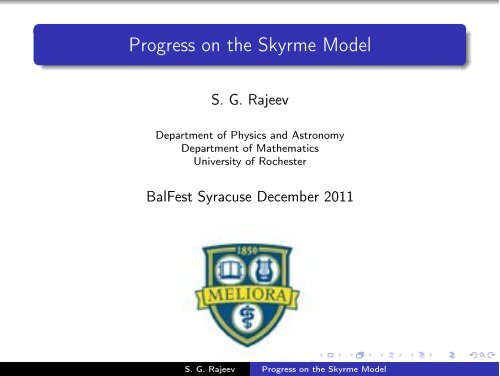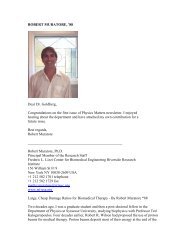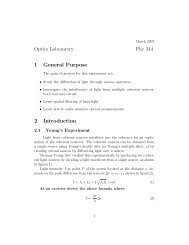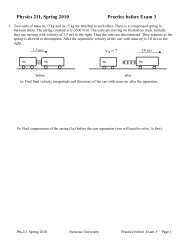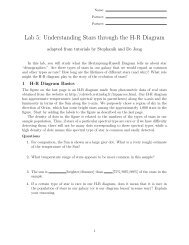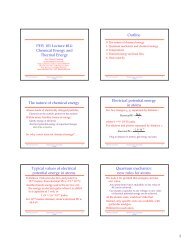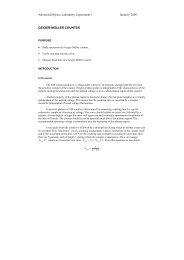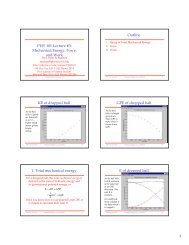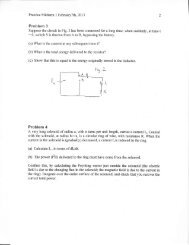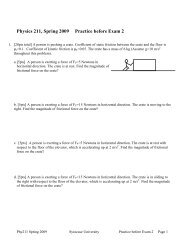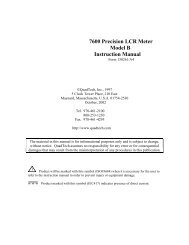You also want an ePaper? Increase the reach of your titles
YUMPU automatically turns print PDFs into web optimized ePapers that Google loves.
1980sThese two ideas were to dominate my thoughts throughoutthe eighties.Skyrme model became a popular subject in 1982; and stringtheory in 1984.Witten’s influence was crucial in both events.The timing could not have been better for me.I feel I have always been lucky: come across the right peopleand the right ideas when I needed them.S. G. <strong>Rajeev</strong> Progress on the Skyrme Model
Early DaysWe got the physical interpretation wrong at first: we thoughtthat the Skyrme soliton would be some new particle withexotic quantum numbers.But I remember noting that if the mesons were coupled toquarks the baryon number of the soliton would be one.Parameswaran told me about Witten’s paper on Baryons in thelarge N limit.Witten visited us to give a seminar (on supergravity) andheard about our ideas on the Skyrme model. His paper onsolitons in current algebra came out a few months later andchanged history.S. G. <strong>Rajeev</strong> Progress on the Skyrme Model
It Takes a VillageAfter Balachandran, the people who influenced me the mostwere Schechter, Christodoulu, Ashtekar and Sorkin.Under Joe’s tutelage, I learned how anomalies have realphysical consequences in meson decays.Dimitri warned me that the existence and regularity ofsolutions of the nonlinear sigma model were not yetestablished; and that some day this should be tackled.IlearnedKahlergeometryfromAbhay;applieditlatertostring theory with Mark Bowick.When I defended my thesis “Baryons as Solitons” , Bal wasway in India. Joe stood in as my advisor.Rafael was in the committee, and scared me by finding amillion typos.S. G. <strong>Rajeev</strong> Progress on the Skyrme Model
1990sItoogotcaughtupintheexcitementofstringtheoryintheeighties.With my first graduate student, Gabriele Ferretti, I returned tothe Skyrme model in 1990s.In three dimensional space-time, QCD has a somewhatdifferent flavor symmetry breaking:U(2N f ) → U(N f ) × U(N f ).The coset space is the GrassmannianWe worked out how baryons arise as solitons in threedimensional QCD. Along the way I became very familiar withthe Grassmannian.S. G. <strong>Rajeev</strong> Progress on the Skyrme Model
IASWhile on leave at the Institute for Advanced Studies, I realizedthat the Grassmannian was key to understanding the entirehadronic spectrum in two dimensional QCD: making it possibleto rewrite QCD as a theory of hadrons. QuantumHadronDynamics.While at the IAS, I met up with Christodoulu again: he hadmoved to Princeton.I talked to him and Tahvildar-Zadeh(mathematics postdoc) about regularity of the Skyrmesolutions. Again he told me that these problems are muchharder than I realize.S. G. <strong>Rajeev</strong> Progress on the Skyrme Model
2000sIs there a relativistic wave equation for the Skyrme soliton?I spent the summer of 1984 at Brookhaven learning aboutrelativistic wave equations from papers of Bargmann, Wigner,Harish-Chandra and Bhabha.But all their equations had mass decreasing with spin, whichwould be physically wrong.Ifinallyfoundawaveequationthatmakessensein2007.By then the Skyrme model was no longer a hot topic.In another direction, with Anosh Joseph, I showed that thereare Skyrme solitons in certains extensions of the standardmodel: the Little Higgs model. Topological Dark Matter.S. G. <strong>Rajeev</strong> Progress on the Skyrme Model
2010sI read on Terry Tao’s blog that mathematicians had justestablished regularity results for a nonlinear version of thewave equation called the “wave map” .Iaskedhimontheblogifitisthesamethingthatphysicistscall the nonlinear sigma model. He confirmed.So the time was ripe to think about the Skyrme modelequations: the difficulties that Christodoulu had warned meabout had been surmounted.S. G. <strong>Rajeev</strong> Progress on the Skyrme Model
Dan GebaDan Geba had just arrived in Rochester after a PhD fromKleinerman and a postdoc fellowship with Tataru: the perfectbackground to work on nonlinear hyperbolic equations.He got excited about the Skyrme model at a seminar I gave tothe geometry group in Rochester.Dan Geba and collaborators (including me in the initial stages)have made progress in establishing existence and regularity ofthe Skyrme model.We looked at the Adkins-Nappi version of the Skyrme modelas well, which is less non-linear (is semilinear).S. G. <strong>Rajeev</strong> Progress on the Skyrme Model
From QCD to HadronsQuantum ChromoDynamics is without doubt the fundamentaltheory of strong interactions. The lagrangian is very simpleL = 14α tr F µνF µν + ¯q[−iγ · ∇ + m]qYet the quarks and gluons of this lagrangian do not appear asasymptotic states: only their bound states do.Mesons are bound states of a quark and an anti-quark. Theyare bosonsBaryons are bound states of three quarks.They are fermions ifthe number of colors is odd, bosons otherwise.There are presumably also purely gluonic bound states(glueballs). But there is as yet no solid experimental evidencefor them.S. G. <strong>Rajeev</strong> Progress on the Skyrme Model
Quantum HadronDynamicsIt should be possible to desribe strong interactions directly interms of hadrons: after all, they are the observable asymptoticstates.So there should be a theory “dual” to QCD, a QuantumHadronDynamics in which all the states are color invariant.It cannot be a quantum field theory: there are an infinitenumber of meson states.It could be a string theory, a field depending on an open curvewith quarks at either end: M(x)= 1 N c¯qe i x A qIn the limit N c → ∞, thistheoryshouldtendtoaclassicaltheory: the commutators [M(x),M(y)] are of order1N c.Baryons would arise as solitons of this meson theory.S. G. <strong>Rajeev</strong> Progress on the Skyrme Model
Classical HadronDynamicsThe Poisson brackets of the meson fields are those of a unitaryLie algebra[M(x,x ),M(y,y )] = δ(x − y)M(x,y ) − δ(y − x)M(y,x )) The hamiltonian isH = ˜M(p,p)+δ(x − y)ε(x,y ) − δ(y − x)ε(y,x ) dpε(x,y)=2π sign(p)eip(x−y)m 2pthe Fourier transform.dp2π + α |M(x,y)| 2 |x − y|dxdy where ˜M isVery important that M satisfy the constraint (M + ε) 2 = 1:lies on a Grassmannian.S. G. <strong>Rajeev</strong> Progress on the Skyrme Model
Equivalence to QCDThe above classical theory can be quantized by finding arepresentation of the commutation relations:M(x,y)= 1 N c: q † (x)q(y):Here, q,q † satisfy canonical anti-commutation relations.The hamiltonian so obtained is exactly that of QCD, in lightcone co-ordinates, after eliminating the gluon fields.Such tricks are only possible in two dimensions.S. G. <strong>Rajeev</strong> Progress on the Skyrme Model
Meson SpectrumThe equations of motion implied by the P.B. and Hamiltonianabove are very non-linearThe linear approximation turns out to be exactly the waveequation that ’t Hooft derived for mesons of large N QCD.Scattering of mesons are suppressed by 1 N c:butcanbecalculated systematically.There are vertices at all orders, as the field manifold isnonlinear (Grassmannian).S. G. <strong>Rajeev</strong> Progress on the Skyrme Model
Baryons are SolitonsBecause (M + ε) 2 = 1, its eigenvalues are ±1.The index of M + ε, (thedifferencebetweenthenumberofpositive and negative eigenvalues) is an integerIf we translate this into the quark representationtr M = M(x,x)dx = 1 N c : q † (x)q(x):dx.This is just the baryon number.The minimum energy configuration in the sector with indexone is the baryon.This is a non-linear integral equation that can be solvednumerically: very reasonable shape of wave functionSeparable variational ansatz M(x,y)=u ∗ (x)u(y) yields avalence quark model.A generalization of the Skyrme model including all the mesonstates.S. G. <strong>Rajeev</strong> Progress on the Skyrme Model
AWaveEquationforSkyrmionsThe Skyrme model predicts the baryon states to have spin andisospin equal to all half-integer values: I = J = 1 2 , 3 2 , 5 2 ···Agrees with the large N c limit of the static quark model.Higher spins 3 2 , 5 2 ··· must have higher masses. In the Skyrmemodel M = m + KJ(J + 1) for some constant K.The wave function ψ(g,x,t) depends on an internal degree offreedom g valued in SU(2) as well as on space and time.The left action of SU(2) on g is spatial rotation; the rightaction is iso-spin.It must change sign under rotations through 2π in g.−i ∂ψ∂t = 12m ∆ xψ + K∆ g ψSpin and orbital angular momentum are separately conserved:OK in the non-relativistic approximation.S. G. <strong>Rajeev</strong> Progress on the Skyrme Model
Relativistic SkyrmionsIs there a relativistic wave equation with this spectrum?Might help us to think of small mass fermions as solitons aswell.For example, there might be a technicolor model in which theanalogues of mesons are Higgs bosons and the analogues ofbaryons are the leptons.The tricky part is to extend the rotations to Lorentztransformations.The obvious generalization ψ + m 2 + K∆ gψ = 0hastoomuch symmetrySpin and orbital angular momentum must not be separatelyconserved in a relativistic theory.S. G. <strong>Rajeev</strong> Progress on the Skyrme Model
Bhabha and Harish-ChandraDirac was never happy with his wave equation for the electron.Specifically, because it predicted negative energy states.Despite the geat success of his prediction of anti-matter!His students Bhabha and Harish-Chandra discovered severalgeneralizations with an infinite number of spins, but withpositive energy.But nature does not use these equations: they predict that themass decreases with spin.Harish-Chandra went on to generalize his theory ofrepresentations of the Lorentz group to an arbitrary simple Liegroup G .But in his work there are ideas that might be useful in physics.S. G. <strong>Rajeev</strong> Progress on the Skyrme Model
ARelativisticWaveEquationRecall that W µ = 1 2 ε µνρσp ν Σ ρσ transforms as a vector.Since SL(2,C) is the complexification of SU(2) anyrepresentation of the rotations can be extended to arepresentation of the Lorentz group by complexification.The equation + m 2 ψ + K 1 W µ W µ + m 2 K 2 ∆ g ψ = 0hasjust the right symmetry: spin and orbital angular momentumare not separately conserved.1+K2 j(j+1)In the rest frame E =(M,0,0,0) we get M = ±m1+K 1 j(j+1)If K 2 > K 1 the masses increase with spin: for very large spinthey approach a constant value though.K 2 = 0issimilartothecasethatBhabhaandHarish-Chandrastudied.There are negative energy states: a hole theory is needed toeliminate them.Can we understand baryon magnetic moments this way?S. G. <strong>Rajeev</strong> Progress on the Skyrme Model
The Wave Map EquationWhat physicists call the nonlinear sigma model is called bymathematicians the Wave Map EquationThe field variable is a map φ : R 1,d−1 → M from space-timeinto a Riemannian manifold MThe action isS = 1 g ij ∂ µ φ i ∂ ν φ j η µν√ −ηdx2Special cases are the wave equation (g ij is flat) and theharmonic map equation η is positive definite.Physicists normally assume that every classical field equationhas sensible solutions: divergences are expected to arise only inthe quantum theory.This is totally false: quite a lot of reasonable hyperbolic PDEshave singularities.The most famous example is Einstein’s equation:Penrose-Hawking singularity theoremsS. G. <strong>Rajeev</strong> Progress on the Skyrme Model
Derrick’s TheoremThe wave map equation has singularities as well: smoothinitial data tend to singularities in finite time, when d ≥ 3.Configurations can decrease their energy by shrinking:U λ (x)=U(λx), =⇒ E[U λ ]=λ −1 E[U]This is one of the first things I learned about the Skyrmemodel(from Al Stern, who was my office mate).If this energy is carried away by radiation, a soliton will shrinkto a singularity.Shatah (and later Turok and Spergel) showed that smoothinitial data of winding number one can evolve in finite timeto a point-like singularity:U(x,t)=e iσ·ˆxu(r,t) ,ru(r,t)=2arctanT 0 − tS. G. <strong>Rajeev</strong> Progress on the Skyrme Model
The Critical DimensionThe scaling argument depends on dimension. In threespace-time dimension, the soliton is neutrally stable.In two space-time dimension, it will tend to expand. So herewe expect regular solutions. Thus three is a critical dimension.In recent years there has been ramatic progress from analystswho have worked out the regularity theory of the wave map.In dimensions above three, typically we have no regularity:singularities arise.The interesting case is the critical dimension: if the initialcondition is regular (belongs to the right Banach space) thesolution will also be regular .Key concepts are continuity and non-concetration of energy.Integral identities that express scale invariance are key to theargument.S. G. <strong>Rajeev</strong> Progress on the Skyrme Model
The Skyrme TermSkyrme’s ideas was to add a term that violated the abovescaling, which would stabilize the static solution.εS = 1 2g ij ∂ µ φ i ∂ ν φ j η µν√ −ηdx+g ij g kl ∂ µ φ i ∂ ν φ j ∂ ρ φ k ∂ σ φ l [η µρ η νσ − η µσ η νρ ] √ −ηdxThe last term is a short-range repulsion. There are now staticsolutions of winding number one.Is it now true that smooth initial data will remain smoothforever?This is the regularity question I asked Christodoulu.Once we have a regularity theory for the wave map, we areready to tackle this question for the Skyrme model.For simplicity consider only the equivariant case (sphericallysymmetric or hedgehog configurations) U(x,t)=e iσ·ˆxu(r,t)S. G. <strong>Rajeev</strong> Progress on the Skyrme Model
The Adkins-Nappi ModelAdkins and Nappi proposed a variant of the Skyrme model inwich the short range repulsion is caused by a coupling thetopological current J µ to a vector meson.S = 1 2g ij ∂ µ φ i ∂ ν φ j η µν√ −ηdx +F µν F µν dx +A µ J µ dxThe equivariant equation of motion, after eliminating thevector meson isu tt − u rr − 2 r u r + 1r 2 sin2u + 1 (u − sinu cosu)(1 − cos2u)=0r 4The last term is the short range repulsion.S. G. <strong>Rajeev</strong> Progress on the Skyrme Model
ContinuityAssume with no loss of generality that the first potentialsingularity is at t = 0andthattheinitildataisgivenatt = −1.Theorem(Geba and SGR) The equivariant solution to theAdkins-Nappi model is continuous at the originu(r,t) → 0,as(r,t) → (0,0)There is still the possibility that the solution may not bedifferentiable.To avoid that we must show that the energy does notconcentrate; and that the energy density controls all thederivatives.S. G. <strong>Rajeev</strong> Progress on the Skyrme Model
Non-Concentration of EnergyTheorem(Geba and SGR) The local energy does not concentrate: T 1limT →0 0 2 (u2 t + ur 2 )+ sin2 ur 2 +(u − sinu cosu)22r 4 r 2 dr = 0To prove this it is important to have a local version of theBogomolny inequality that relates the energy density to thetopological charge density.Whether the finiteness of energy density is enough to make all thederivatives continuous is not clear yet. Dan Geba and hiscollaborators are continuing to work on this. The analysis is gettingtoo deep for me though.S. G. <strong>Rajeev</strong> Progress on the Skyrme Model
ThanksThanks Bal !For many years of inspirationAnd many more to come.S. G. <strong>Rajeev</strong> Progress on the Skyrme Model


